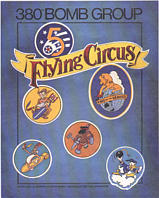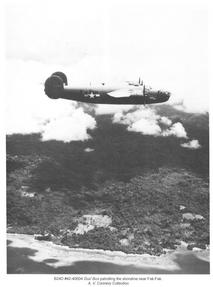 |
WE WENT TO WAR
PART V: THE PLANES WE FLEW - AUSTRALIA/NEW GUINEA CAMPAIGN
Compiled by Theodore J. Williams and Barbara J Gotham
With Acknowledgment and Thanks to
Glenn R. Horton, Jr., and Gary L. Horton
and others where indicated
for the Nose Art Pictures of all Aircraft
February 2002 -- Updated February 2006
|
 |
Contents
INTRODUCTION
This aircraft listing has been prepared to insure the remembrance of all
those "faithful steeds" who served their aircrews so well when with the 380th
Bombardment Group (Heavy), Fifth Bomber Command, 5th Air Force, Far East Air
Forces, USAAF, during World War II. In this work the group will be
represented by the terms 380th Bomb Group (H), 380 Bomb Group, 380th, or
Group for brevity. The listing has been prepared under the auspices of the
380th Bomb Group Association, the organization of wartime veterans of service
in the 380th Bomb Group and their families and associates. Australian
veterans who served with or worked with the 380th are also welcomed as
members of the Association.
The basic unit of the United States Army Air Forces during World War II was
the Group. Groups were built around the operational use of a specific type
of airplane. In the case of the 380th, this was the B-24 Liberator Bomber.
These planes were used in a particular class of mission suited to their
capabilities. Again, in our case this was heavy bombardment associated with
a large fraction of reconnaissance missions, particularly in the Australian
phase of our service in the 5th Air Force as covered in this volume.
The 380th was assigned to the South West Pacific War Area because of the
long-range capabilities of the Liberator and the need for its services there
at that point in the war (Spring 1943).
The 380th was initially assigned a unique mission, the strategic bombardment
coverage of the whole of the Western half of the South West Pacific Area.
This comprised the whole of the East Indies including Dutch New Guinea within
range of our bombers. In other words, they were holding the left flank of
the Allied effort in the South West Pacific Area during the 1943-44 period.
When needed, the 380th joined their compatriot groups of the 5th Air Force in
New Guinea for short periods such as during the several invasion campaigns
that occurred there in 1943-44.
To accomplish this mission, the Group was placed under the
operational control of the Royal Australian Air Force based in the Northern
Territory of Australia. As such they served the longest of any American unit
under the direct operational control of an Allied Country. This service
lasted from May 1943 to February 1945 when the Group again rejoined their
American comrades in the Philippines as the war zone moved to that area of
the Pacific.
In preparation for that move, the 380th carried out another unique
mission, that of training our Australian replacements to fly and fight the
Liberator so they might take over the East Indian mission that the 380th was
then leaving.
This volume will cover all those aircraft that served with the 380th during
the Australia/New Guinea phase of our service in WWII as noted just above.
The succeeding volume will cover those aircraft involved in missions flown
from The Philippines, including those aircraft that served in both areas. A
total of 137 planes served in Australia and New Guinea. Of these, 53 served
further in The Philippines.
The authors regret any mistakes that may have crept into this
compilation and we take full responsibility for such. We will welcome any
comments or corrections from the readers of this book and the other parts of
this compilation, and will make every effort to correct them.
We will incorporate all corrections and
additional data that we receive in this compilation on the
Errata-2 page.
Included in this and the succeeding volume is a series of descriptions of
the various models of the B-24 Liberator bomber as its design advanced over
the period of its use in WWII and as we used them. Sadly, the Liberator
effectively disappeared at the end of the war, when most of them were
destroyed to make way for the newer designs from the fast-developing aircraft
industry.
References
Glossary of Abbreviations and Acronyms Used
Click here to download all the text of Part V up to the Aircraft Types (in
Adobe Reader PDF format).
ISBN 0-9672447-4-9
Library of Congress Catalog Card Number 99-73366
Copyright © 2002 by Theodore J. Williams
All rights reserved. No part of this publication may be reproduced, stored in a retrieval system or transmitted in any form or by any means, mechanical, photo-copying, recording, or otherwise, for commercial purposes, without the prior written permission of the publisher. However, private use for historical research or related purposes is hereby granted on condition that credit be given to this publication and its authors.
Published by:
Theodore J. Williams
West Lafayette, IN USA
PART V
CONTENTS
Introduction
About This Aircraft Listing
Notes Concerning Each Entry
Collection of Data
Distinctive Models of the B-24 as Used in the Southwest Pacific
Designation of Individual Missions in the Southwest Pacific
Group and Squadron Identification by Tail Marking
Statistical Summary of Aircraft Fates
Maps Showing Targets
Glossary of Abbreviations and Acronyms Used
Acknowledgments
References
Aircraft Types
The Aircraft
Appendix I: Complete Aircraft Listing showing ...
Serial number
Squadron assignment
Nose art name
Fate
Appendix II: Statistics on Nose Art Popularity
Appendix III: Mystery Aircraft
Return to the 380th Bomb Group Association homepage
Last updated: 10 May 2021

